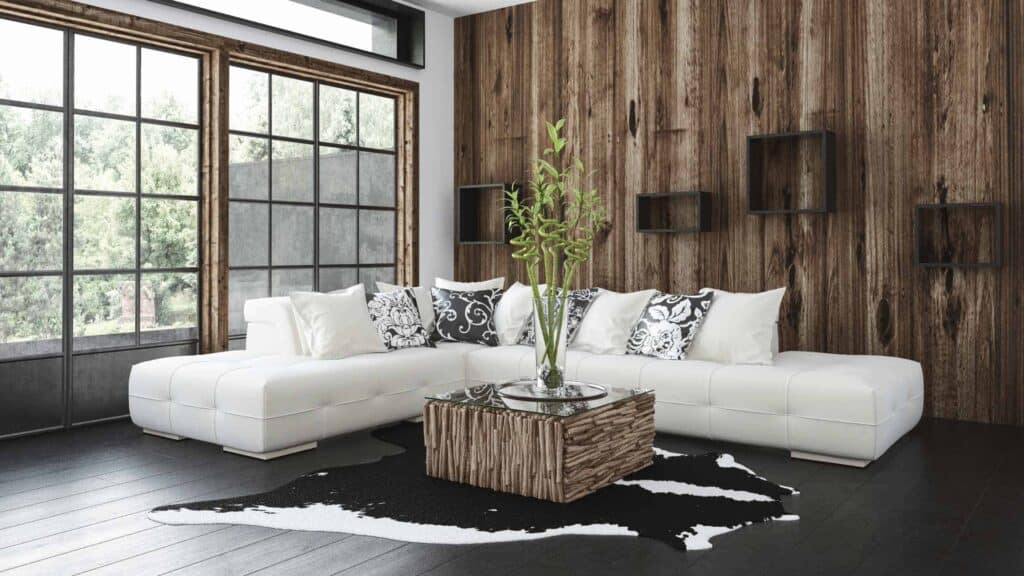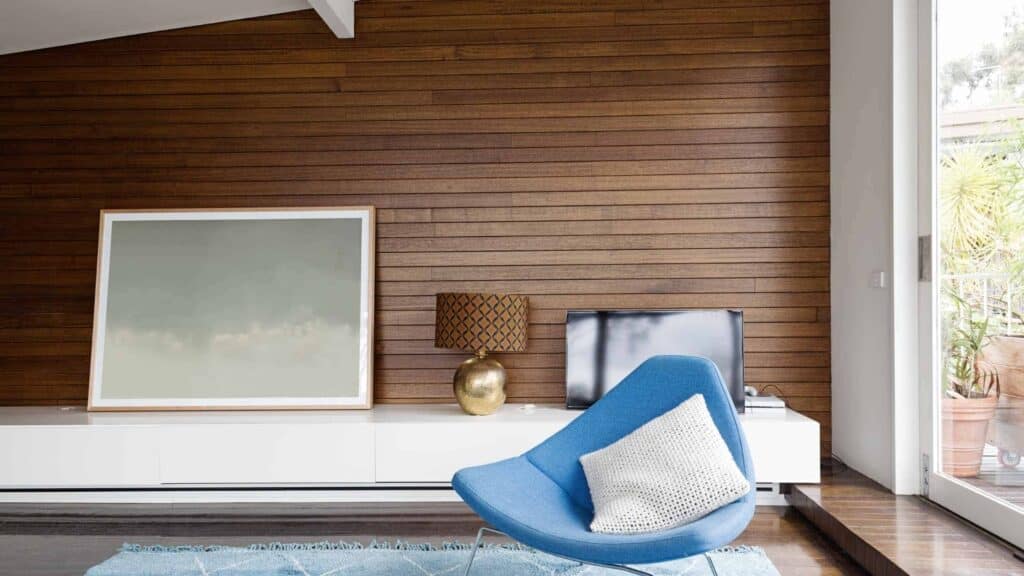In this article, we’ll explore wood paneling ideas for your workspace, from creating a partition wall to adding texture to your ceiling. Whether you’re looking to create a rustic or modern look, these tips will help you achieve a professional and stylish workspace.
Wood is a well-known and beloved material that is frequently utilized and desired in residential and commercial construction. Wood paneling may add warmth and elegance to any workstation, resulting in a professional and attractive environment. Yet, determining how and where to use wood paneling can be difficult.
What Is Wood Paneling?
Wood paneling is a wall treatment comprised of thin wood panels. When plaster walls became popular, home builders employed wood paneling for structural purposes. The design had a major reappearance during the mid-century modern era, and it is widely used in new building and remodeling projects today. Most modern wood paneling, on the other hand, serves no structural purpose and exists solely to lend character to blank walls.
In addition to adding beauty to places, wood provides a sense of connectedness to nature. It is used by architects and interior designers to “warm up” areas by transmitting a sense of warmth and breaking the chilly look sometimes generated by porcelain and ceramic surfaces.
Yet, because natural wood is a material harvested directly from nature, its use in a project is not always practicable. It is far from being an economical or ecological choice.
To address these concerns, industrialized wood panels (also known as MDF, MDP, and HDF panels) are an excellent solution. This helps to enjoy the benefits of wood while still having economic, sustainable, and practical advantages.
Furthermore, industrialized wood panels have the benefit of being a lightweight material (far lighter than natural wood). It is simple to install, which optimizes the process and time of the work. Taking these and other material properties into consideration, we have compiled a list of crucial suggestions to assist professionals in selecting and specifying wooden panels in their projects.
5 Wood Paneling Styles – Types of Wood Paneling

Wood paneling can be made from a variety of lumber. Solid wood, plywood, salvaged wood (also known as recovered wood), corkboard, and fiberboards such as pressed wood or MDF are examples. Architects and designers can enjoy a range of wood paneling styles when using these types of wood, including:
1. Beadboard
Beadboard is constructed from large strips of wood with carefully cut edges. A typical design includes two-and-a-half-inch-wide strips with a beaded edge on one side (the tongue side) and a rounded edge on the other side (the groove side) that cover the joint. Certain beadboards have chamfered edges rather than rounded edges.
2. Shiplap
Shiplap paneling dates back centuries. These boards have interlocking connections that allow for little overlap (although some builders intentionally insert an eighth-inch gap to make each individual board stand out). If the millwork on your wood planks is of high quality, installing a shiplap wall should be simple.
3. Drop Siding
This shiplap paneling type includes a curved face on one side of the board, making it suitable for horizontal alignment. Choose real wood for drop siding, whether you’re making an exterior or interior wall covering because it highlights the grain of natural wood.
4. Board-and-Batten
This wood wall paneling style is appropriate for both interior and exterior walls. It consists of wide strips of wood set side by side, with the seams between these wide boards covered by a much thinner strip of wood known as a “batten.”
5. V-Groove
V-groove boards are chamfered on both edges and are a popular interior style. A tongue-and-groove carving beneath these borders allows the boards to connect easily.
9 Wood Paneling Ideas – Tips For Wood Paneling Installation
1. Wood Paneling For Walls

One of the most common uses for manufactured wood panels is wall cladding, which gives personality and originality to projects. As long as panels are not installed in damp locations, there is a wide range of finishes accessible for use on internal walls (innumerable hues and textures are available on the market).
Hardwood panels can be used in both large and small locations. For example, in a tiny apartment, the panel can be utilized to increase the length of the wall and create a sense of vastness in the room.
This material can also be applied to television panels, which are often used in decorating environments owing to their practicality and versatility. In addition to the aesthetic issue, it also serves to hide all of the TV wiring and equipment, which creates an unorganized appearance in the room space.
The colors and textures of the panels must be chosen in accordance with the overall concept of the project, keeping in mind that comfort and well-being are key elements for the entire project.
2. Wood Panel In Bathroom
Contrary to popular belief, industrialized wood panels can be used in humid environments as long as they meet the necessary specifications. The manufacturer provides this information. As a result, anytime wooden panels are used in humid locations, such as bathrooms or kitchens, the finish must be specifically designed for this purpose.
It is intriguing to use wood in bathrooms and washrooms to offset the potential coldness generated by tiles, making the space aesthetically more appealing and cozy. Wood paneling is also suitable in the kitchen as wall cladding and as a complement to counters and cabinets.
Because the core of the panel has a greenish appearance, it is easy to tell when it is resistant to humidity. Still, always check with the manufacturer to determine the correct application for each type of panel. It is worth noting that, despite its moisture resistance, the wooden panel should not be installed in locations with infiltrations or in internal areas.
3. Fire Protection Wood Paneling Design
Another fact that many designers are unaware of is that certain industrialized wood panels contain properties that delay and prevent the spread of flames in the event of a fire. These panels can be used in dry interior environments on walls, ceilings, floors, and furniture. They are suitable for high-traffic commercial places that require security, such as theaters, cinemas, schools, hotels, and shopping malls.
Check with the manufacturer to see if the selected panel has a fire retardant function. It is also critical that the product has the Fire Department’s and other regulatory authorities’ seals of approval.
4. Furniture With Wood Panels
Another fascinating application of industrialized wood panels is in the production of furniture such as benches, counters, cabinets, cupboards, benches, and so on. The environment in which it will be installed must first be analyzed for this purpose, including if it is prone to moisture or infiltration. This information will be used to identify the type of panel that will be utilized.
The panels can be utilized in both loose and permanent furniture, such as table tops and bed headboards. The big advantage is that you can design the items precisely how you want them in the project and choose the most appropriate texture and color based on the overall environment.
5. Wooden Lining Panel
It is also feasible to use industrialized wood panels for ceiling cladding. The weight of the material is a significant benefit over natural wood lining at this point. Because it is much lighter, it is easier and more practical to install, saving money on the overall project cost.
To select the type of panel to install in the ceiling, follow the same approach recommended for wall specifications. Examine the features and functions of the area where it will be installed in terms of humidity and infiltration, as well as the necessity to protect the ceiling from fire.
6. Partitions
In addition to wall coverings, wooden panels can be utilized as dividers or to support an internal structure. Screws or fitting details are used to secure the panels to the structure. Partitions have a benefit over walls in that they provide more space flexibility because they are easy to assemble and disassemble, allowing for the creation of varied environments.
Furthermore, features such as on-site cleaning and reduced thickness are advantages over conventional walls.
7. Doors With Wooden Panel
Wood panels can also be used to adorn settings by covering door frames. This is an intriguing design option since it allows you to replicate the doors using the wooden panels that cover the walls. The apertures “disappear” in this manner, providing continuity of surfaces and a highly unique visual effect.
8. Lighting Details
The wooden panels can also be used to produce different lighting effects in the joinery. Because of the material, lights can be totally incorporated into shelves or recesses, for example, creating a comfortable ambiance in the settings. Furthermore, you can employ light strips or other types of lighting such as recessed lighting in backlit headboards, panels, and mirrors.
9. Size Of The Wood Panel Board
Another tip for employing wooden panels is to consider the size of the panels on the market. Because it is an industrial material, the size criteria vary depending on the manufacturer and the sort of finish attained. Furthermore, the panel thicknesses range from 6 to 18 mm.
It is critical to examine the dimensions and thickness of the boards in panel and furniture projects so that potential splices and patterns can be appropriately planned, making the end product even more intriguing. Wooden panels, with their variety and ingenuity, can be valuable allies in projects that strive to improve spaces in a more cost-effective and environmentally friendly manner.
Conclusion – Wood Paneling Ideas
Wood paneling can be a great way to elevate the look and feel of your workspace, adding a touch of sophistication and charm. By following these wood paneling ideas, you can create a space that reflects your personal style and enhances productivity. From accent walls to creative ceiling designs, the possibilities are endless with wood paneling. So, start planning and let your creativity shine!
